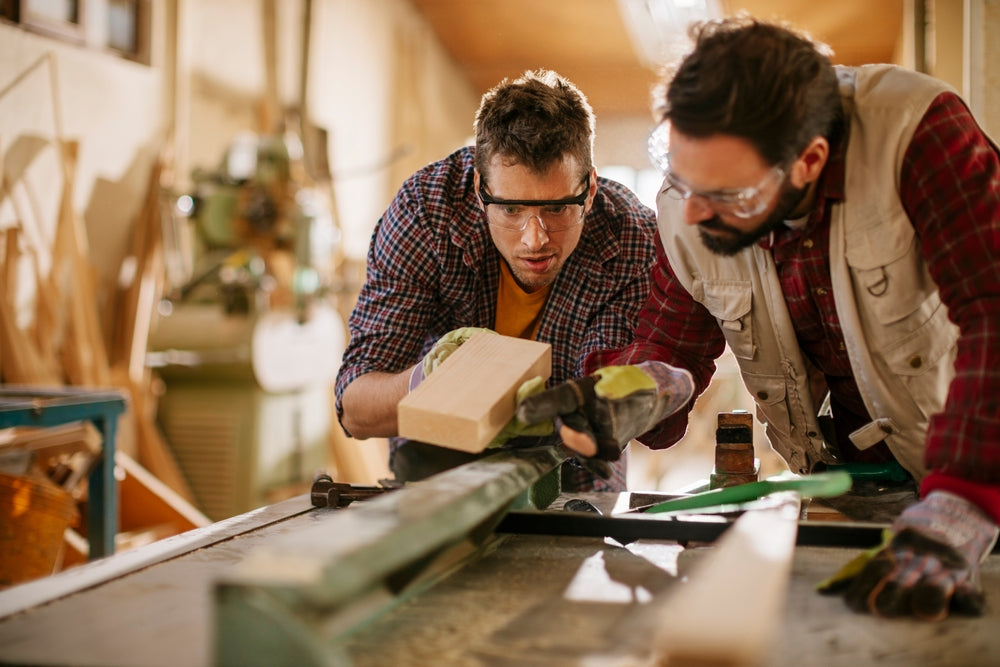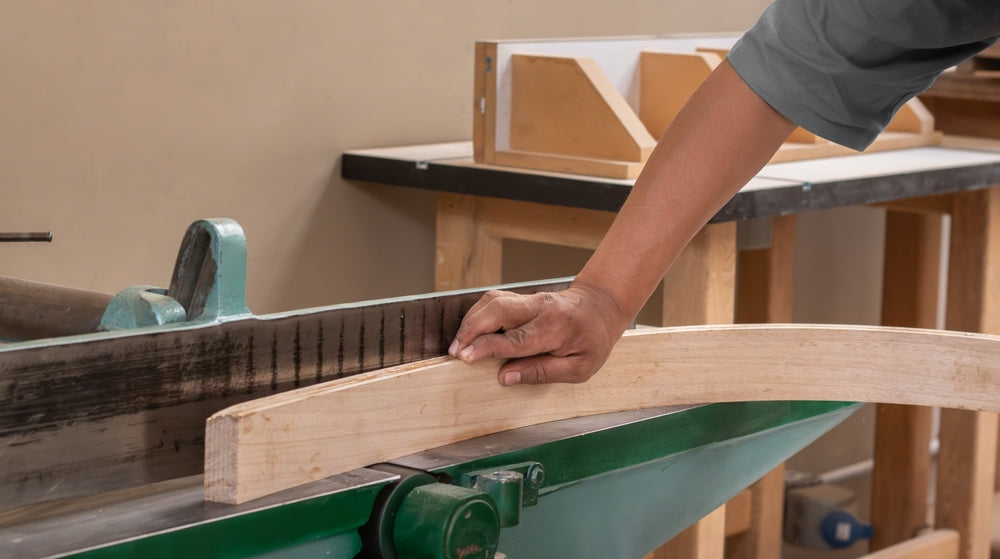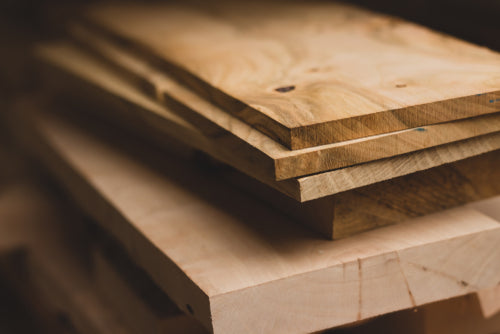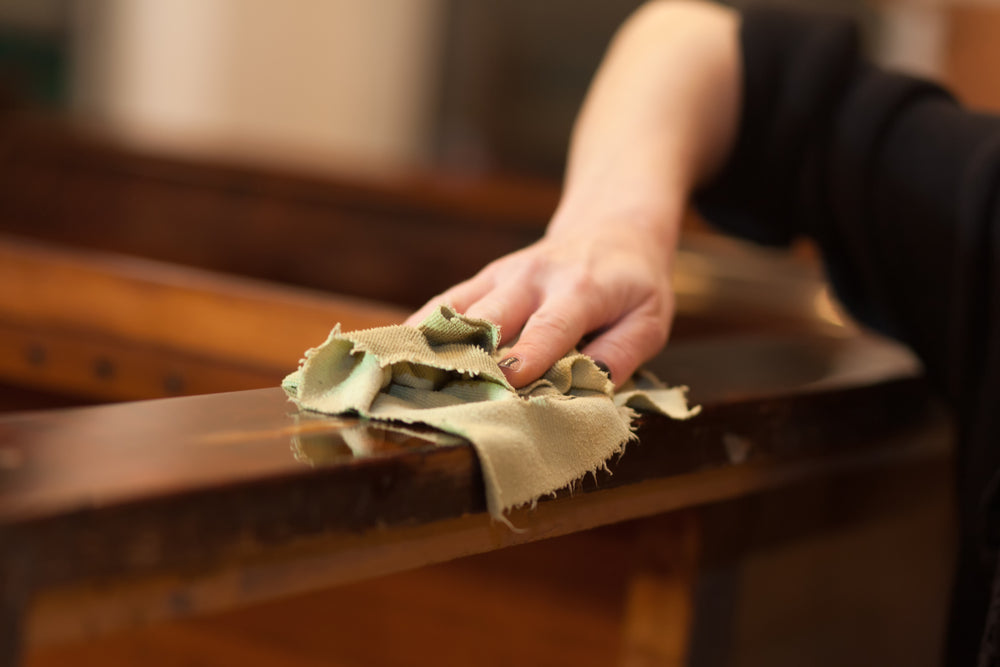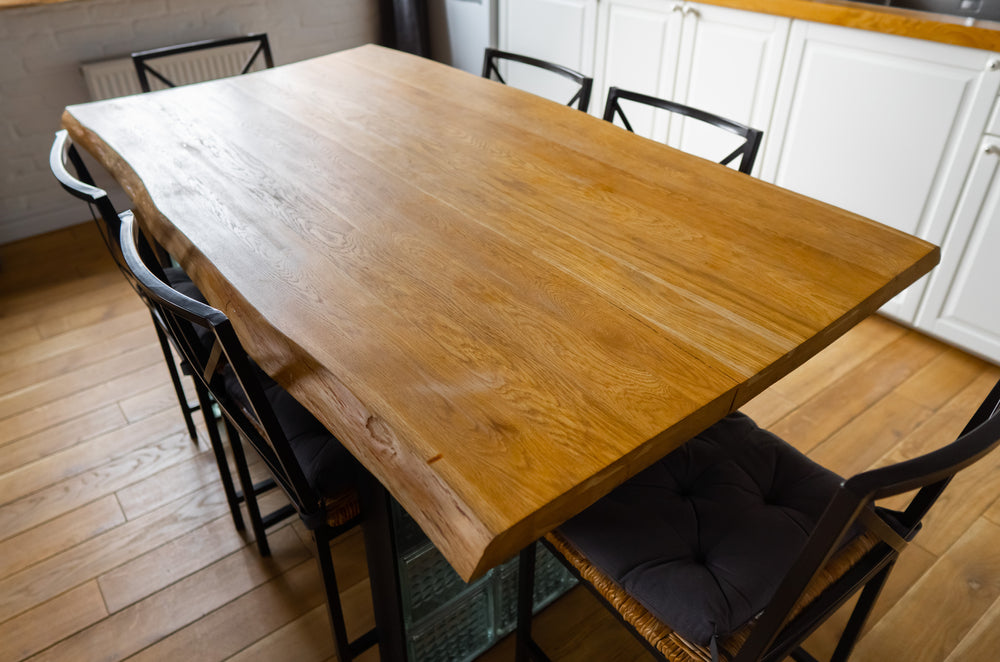Woodworking shops are great creative spaces where practical skills and aesthetic aspirations combine in craft. Every time-served woodworker has had a splinter or two, it comes with the territory, but there are serious risks to consider when working with machines and sharp tools.
While it’s wise for your workshop to have a properly stocked first aid kit, no one looks forward to using it! We’d all much rather enjoy a safe and productive time making, rather than taking trips to the emergency room.
So, how best to stay safe in the shop? Here are our thoughts on preventing the most common injuries.
Keep It Tidy
A tidy workshop is a safe workshop. Keeping tools neat is only part of the story. Get yourself a decent dustpan and brush. Don’t let me catch you using your hands to clear up shavings or sawdust.
Pick up those offcuts and put them in the bin, either for re-use, or firelighting, just get them off the floor so you, or anyone else won’t trip over them. Sawdust can be slippery underfoot too!
I suffer from tool blindness all the time. I put something down and a minute later I can’t find it again. It’s why I have so many tape measures dotted around the workshop. I keep my tools tidy, and replace them back in the same spot after each session, so the house pixies don’t hide them from me.
Sawdust Safety
Sawdust can cause all manner of problems in a workshop. If you can’t invest in a dust-extraction system, you could attach an industrial vacuum cleaner to your equipment, or failing that, invest in a decent half-mask respirator, one with cassettes that can be replaced.
Sanders come with bags attached to collect the dust, but they don’t catch it all, and a mask is essential if you want to keep your lungs healthy.
The other issue with sawdust is that it is a fire hazard. If you are a fan of finishing, then make sure you have a sealed container in which to keep any soiled rags. Linseed oil, solvents, and varnishes are particularly prone to fire risk, so keep an extinguisher handy too, just in case.
Hand Safety
A woodworker’s hands are their fortune, but they are exposed to multiple hazards in the workshop. The best way to protect your hands is to remain in control at all times.
Blunt tools are harder to work with, and will lead to a woodworker applying more pressure to a piece than is required. The sharper the chisel, saw, or other blade, the more control there will be, as less effort is needed to guide the tool, or stock.
Hands are on the frontline, working close to spinning blades, bits, augers, and sanding tools.
Keeping Hands Safe
Keep to the six-inch-rule, and keep your fingers at a minimum distance when cutting with a machine tool.
Keep your hands behind the blade, when paring, or carving with a chisel, always push away from your body, and hold the stock behind the area on which you are directing a cutting edge.
Keep things sharp, take the time to hone the edge of your chisels, file your traditional saw teeth, or swap out the old, worn-out blades sooner rather than later.
Take it slow. Woodworking should be time-consuming. Getting it right is more important than getting it done. It’ll get done in good time, not by rushing
Eye Safety
A wood workshop can produce a number of airborne hazards; chips, sawdust, splinters, and unsafe material such as loose knots, can all find themselves up in the air.
Whether using hand tools, portable, or sited machine tools, it’s always a good idea to use robust eye protection.
It doesn’t mean that you need goggles, a solid pair of impact resistant perspex eye protectors work well. They can fit easily over eye glasses too if you need them to see the work piece properly.
Eye glasses are not designed to protect you from the impact of flying debris, so don’t rely on them to keep your sight safe!
Pro Tip:
I keep a pair with the tools, and any other personal protective equipment (PPE) required, next to each workshop machine.
Ear Safety
The machines in a woodworker’s armoury can make an almighty din, especially when planing hard wood, or knotty stock. Buy the absolute best noise-cancelling headphones you can afford. They will be cheaper than the hearing aids you may come to depend on later once the damage is done.
Another bonus of excellent eaér protection is that it will help you to focus. Many accidents happen due to distraction or loss of concentration.
I find that when I’m wearing my 3M Peltier Optime ear defenders I become totally engrossed in the task at hand. It’s almost like a meditation, or prayer.
Pro Tip:
Do not overtighten vices! When you are done using a vice, always leave it loose with the handle hanging vertical. They’re not nice to walk into!
Hearing the Hazard
When you turn a machine on for the first time, if it doesn’t sound right, turn it off again. A loose fixing, an improperly secured blade, or a foreign object lodged in a mechanism can all be dangerous.
Wait for the moving parts to stop, then inspect for debris, or any loose nuts, bolts, or clamps. A noisy vibration is also not okay, and is an indicator that your machine is not safe to use.
Disconnect power tools when making any adjustments, fitting cutters, bits, or raising or lowering blades. At the wall, always pull on the plug and not the cord!
Pro Tip:
If you are lucky enough to have a slot mortiser in your shop, that’s terrific. However, you must always check that the chuck key has been removed before you start it up. The chuck key is easily forgotten once. If left in, it can be thrown out at incredible speed.
Kickbacks: An Avoidable Table Saw Hazard
A kickback is a classic instance of a woodworker losing control of a piece they are working with. When a piece encounters too much resistance, either from a saw blade that is improperly adjusted, a fence that is at the wrong angle, or a riving knife that is worn and in need of replacement, kickback can occur.
If you’re lucky the piece will be propelled past you. If you are unlucky, the stock could hit you at speed, or your hands may come in contact with the blade.
It is the number one reason why a woodworker ends up in the emergency room. Here’s how not to contribute to the statistics:
Check the depth of the saw blade. It should project between ¼” and ⅜” above the stock, or at the least, enough to clear the common gullets between the saw teeth.
Check you are using the right attachments. The fence is for ripping, and the miter gauge is for cross-cutting. Don’t get them mixed up, or decide to use one for both activities.
-
Never reach over the blade
-
Keep your hands off the table
-
Use a push stick when ripping 6” or less
-
Always push past the blade to avoid kickback
-
Scrap to the outside! Never between the blade and the fence
-
Do not be tempted to ‘freehand’ to save time
-
Ensure the guards and riving knife are securely in place
-
Hold the piece flat to the table and tight to the fence
The Riving Knife
Check the riving knife. A lot of older machines were sold without a riving knife, but in the old days, there were fewer one-person workshops. Some of these old-timers are still going, and the good news is that you can fit an ‘after-market’ version.
The riving knife is there to open up the cut and prevent the wood from closing up on the other side of the blade. Without it, the piece could put pressure on the blade and be forced off the table. This is referred to as binding.
Common Workshop Machine Best Practice
Staying focused on the job in hand is just part of the story when it comes to safety in the shop. There are general considerations too, such as keeping long hair, including beards, tidy, not wearing loose clothing, and minimizing distractions. Checking that the material is safe to use, i.e. that there are no knots or checks, is also important.
For individual machines, there are other things to consider:
The Chop or Radial Arm Saw
-
Keep a minimum distance of 6” between your fingers and the blade
-
Keep your thumb close to your fingers
-
Let the blade do the cutting, don’t force it
The Band Saw
-
Push sticks are a must-use on a band saw
-
Do not let the blade bind, always keep it as loose as possible while maintaining control
-
If you hear a clicking noise it’s likely the blade is either split, or there’s a kink in it. Stop the machine and replace the blade immediately
Nail Guns
-
These guys are great, but like a forearm, dangerous too. Never point them at other people or body parts
-
Check the nose guards and look out for knots. Hard grain or a tough knot can deflect a nail sideways!
-
I took a co-worker to the emergency room one day when he fixed a piece of 2 x 4 to his hand with a 6” nail gun. That workday has lived long in the memory!
The Lathe
-
Always stand to the side when starting up the lathe in case of failure. A piece can come off at speed if it is not secured
-
Allow any glued stock to fully cure before putting on a lathe (I’d recommend at least 24 hours)
-
Make sure everything is tightened up properly too, and stop the machine to adjust the tool rest regularly
The Planer/Thicknesser
-
Always start the work at the thickest measurement before beginning to reduce, just to even it out
-
Never go more than 1/16” at every pass, any more will put too much pressure on the piece
-
Never adjust the planer while it is running. If you’ve made a mistake, it’ll be less than 1/16”, so don’t worry too much
At the end of the day, a piece of timber is replaceable, a piece of you, maybe not so easy! So take your time, and take care in the workshop!
At North Castle Hardwoods we have generations of safe and satisfying wood workshop experience with selected American lumber. We supply premium dimensional lumber that has been specially selected for the discerning woodworker and furniture maker. Call or visit us today to pick out lumber you can rely on.
